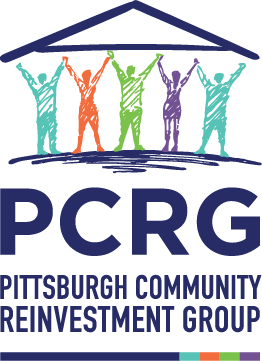As National Homeownership Month gets underway, Pittsburgh Community Reinvestment Group (PCRG) is highlighting the critical role homeownership plays in creating economic stability and generational wealth — particularly for first-time buyers and historically excluded communities.
In a city where housing costs remain more affordable than national averages, deep and persistent gaps in access and affordability still require intentional policy solutions — both locally and nationally. That’s why PCRG is spotlighting federal proposals like the Neighborhood Homes Investment Act (NHIA), ongoing homebuyer assistance programs from Allegheny County and the Urban Redevelopment Authority (URA) and the expansion of Special Purpose Credit Programs (SPCPs) by banking institutions.
Pittsburgh’s Homeownership Trends: Progress and Pressure
Pittsburgh’s current homeownership rate stands at approximately 69.5% — above the national average of 66%. But equity in access remains elusive. According to PCRG’s Black Homeownership Report, Black homeownership in Pittsburgh fell from 37% in 2010 to just 30% in 2019 — while the overall homeownership rate decreased from 51.4% to 45.1%. Home values soared over 60% during that same period.
According to PCRG research, investor activity in the region has surged over the past decade — reshaping the market. In the City of Pittsburgh, the share of homes sold to corporate entities or real estate investors rose from 15.5% of all sales in 2010 to 24.8% in 2021. Communities throughout the rest of Allegheny County saw a similar trend, with investor purchases increasing from 9.7% to 18.0% over the same period. This growing investor footprint continues to limit the availability of affordable homes for first-time buyers and local residents. In 2020, corporate buyers accounted for 1 in 6 single-family home purchases, driving up prices and reducing inventory in first-time buyer neighborhoods. The median home price in Allegheny County has risen to $254,000 — up nearly 5% from a year ago — with limited listings and high construction costs creating significant affordability hurdles.
Rising Costs Undermine Affordability Efforts
Both new construction and the rehabilitation of existing homes have become increasingly expensive due to labor shortages, rising material costs, and appraisal gaps. Developers frequently report that the cost to build or rehab homes in disinvested neighborhoods now exceeds appraised values, leaving projects financially unviable without subsidy.
This is where federal and local interventions are critical.
Federal Policy Spotlight: Closing the Appraisal Gap with NHIA
The Neighborhood Homes Investment Act (NHIA) is a bipartisan proposal designed to close the financing gap for single-family homes in distressed communities. It would:
Provide federal tax credits to cover up to 40% of construction costs and 50% of rehabilitation costs
Require resale to owner-occupants at affordable prices
Support the development of 500,000 homes over 10 years, while creating 1 million jobs and generating over $1 billion in economic activity
Encourage revitalization in communities where developers face a “valuation gap” between rehab costs and resale price
PCRG is urging Pennsylvania Senators to co-sponsor this bill (S. 1686) and include it in the upcoming federal tax package.
The NHIA would unlock capital and help stabilize communities across Pennsylvania where conventional development models are no longer affordable.
Local Programs Driving First-Time Homeownership
Locally, several key programs are helping residents take the first step into homeownership:
First Home Allegheny Program offers up to $10,000 or $45,000 in down payment and closing cost assistance to qualified households purchasing in the county — but outside the City of Pittsburgh. Income limits apply, and participants must complete homebuyer's education.
The Urban Redevelopment Authority (URA) administers the OwnPGH Program within city limits. This includes affordable mortgage products, grants, and deferred second loans, plus access to HUD-certified pre- and post-purchase counseling through HUD certified agencies.
The newly launched 1st Home Allegheny pilot, funded with $2.6 million, aims to help around 90 buyers in its first round with up to $45,000 in assistance — underscoring both demand and commitment. While the URA’s OwnPGH program has closed 100 home purchases since its launch in 2023. It has provided an average of $55,200 in grants to serve a majority-Black (60%) cohort — demonstrating impactful progress in equity-focused homeownership access.
These efforts provide critical gap financing for those with limited assets but stable incomes — ensuring the door to homeownership isn’t closed by up-front costs.
Special Purpose Credit Programs: The Banking Sector’s Role
In addition to public-sector tools, banks have introduced or expanded Special Purpose Credit Programs (SPCPs) in recent years — targeting communities and individuals historically excluded from lending opportunities.
These programs, encouraged by the Consumer Financial Protection Bureau (CFPB) and the Office of the Comptroller of the Currency (OCC), allow banks to legally offer favorable terms to address disparities in homeownership. Common elements include:
Low or no down payment options
Flexible underwriting terms
Discounted interest rates or grant assistance
Targeting of majority Black or Latino census tracts or first-generation buyers
The locally headquartered F.N.B. Corporation’s ‘Homeownership Plus’ SPCP now offers $5,000 closing-cost grants, zero down payment, no Private Mortgage Insurance requirement, and utilizes alternative credit criteria such as rent payment history, targeting support in majority-minority neighborhoods.
PCRG supports the continuation and greater transparency of SPCPs as a market-driven strategy to help correct inequities in mortgage access.
“Homeownership remains the most reliable path to wealth for working families,” said PCRG’s Director of Policy Chris Rosselot. “But access is not equitable, and affordability is increasingly fragile. Local solutions help, but federal policy like NHIA is a game-changer. We can’t afford to let this moment pass.”

